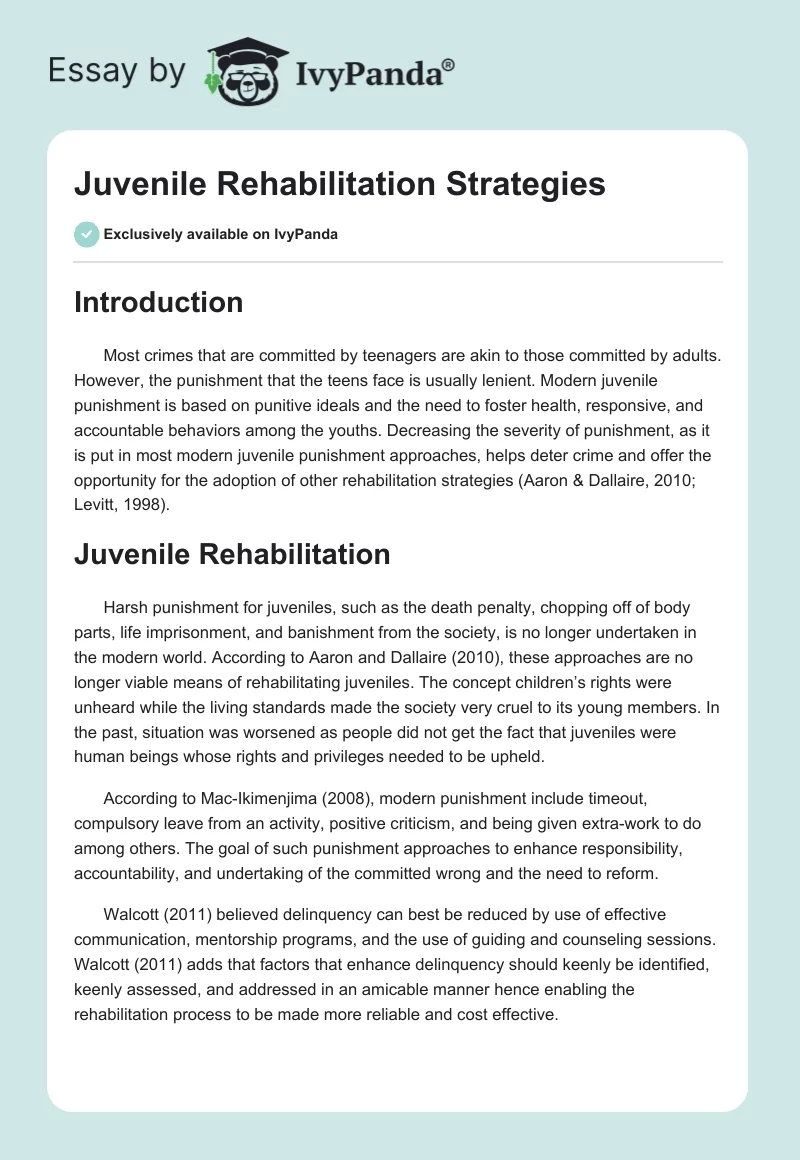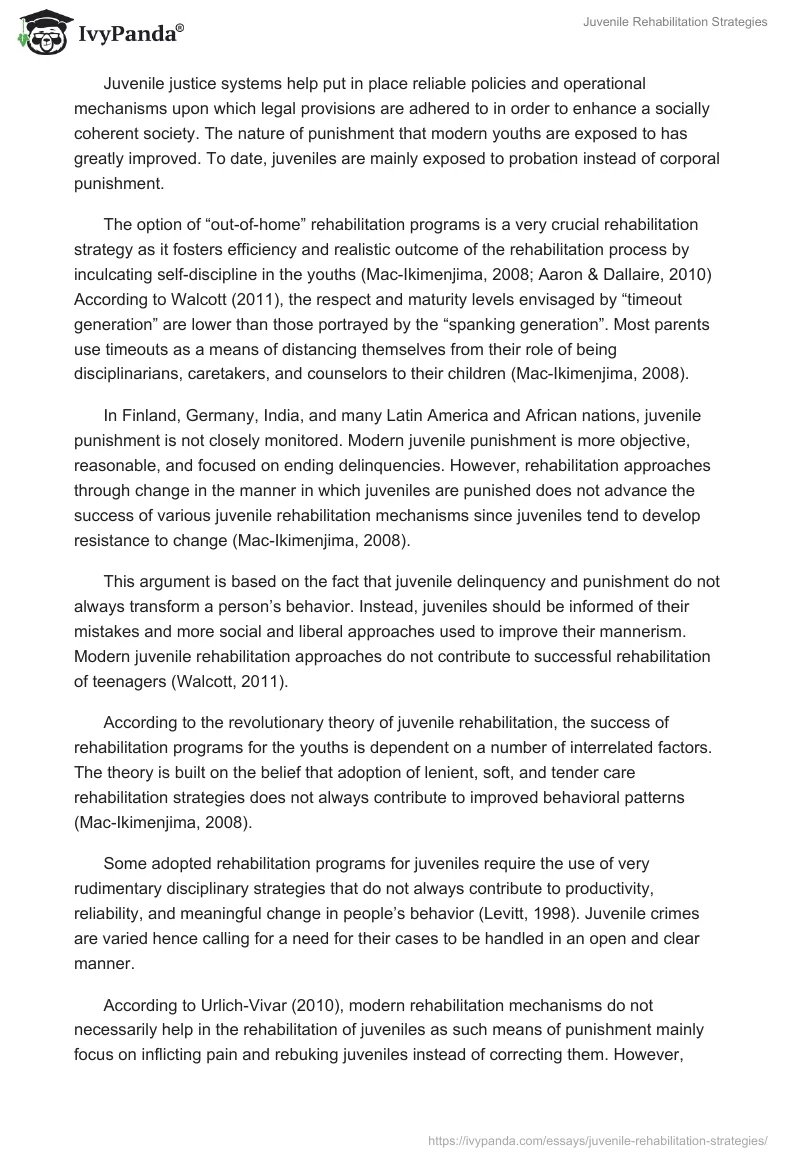Introduction
Most crimes that are committed by teenagers are akin to those committed by adults. However, the punishment that the teens face is usually lenient. Modern juvenile punishment is based on punitive ideals and the need to foster health, responsive, and accountable behaviors among the youths. Decreasing the severity of punishment, as it is put in most modern juvenile punishment approaches, helps deter crime and offer the opportunity for the adoption of other rehabilitation strategies (Aaron & Dallaire, 2010; Levitt, 1998).
Juvenile Rehabilitation
Harsh punishment for juveniles, such as the death penalty, chopping off of body parts, life imprisonment, and banishment from the society, is no longer undertaken in the modern world. According to Aaron and Dallaire (2010), these approaches are no longer viable means of rehabilitating juveniles. The concept children’s rights were unheard while the living standards made the society very cruel to its young members. In the past, situation was worsened as people did not get the fact that juveniles were human beings whose rights and privileges needed to be upheld.
According to Mac-Ikimenjima (2008), modern punishment include timeout, compulsory leave from an activity, positive criticism, and being given extra-work to do among others. The goal of such punishment approaches to enhance responsibility, accountability, and undertaking of the committed wrong and the need to reform.
Walcott (2011) believed delinquency can best be reduced by use of effective communication, mentorship programs, and the use of guiding and counseling sessions. Walcott (2011) adds that factors that enhance delinquency should keenly be identified, keenly assessed, and addressed in an amicable manner hence enabling the rehabilitation process to be made more reliable and cost effective.
Juvenile justice systems help put in place reliable policies and operational mechanisms upon which legal provisions are adhered to in order to enhance a socially coherent society. The nature of punishment that modern youths are exposed to has greatly improved. To date, juveniles are mainly exposed to probation instead of corporal punishment.
The option of “out-of-home” rehabilitation programs is a very crucial rehabilitation strategy as it fosters efficiency and realistic outcome of the rehabilitation process by inculcating self-discipline in the youths (Mac-Ikimenjima, 2008; Aaron & Dallaire, 2010) According to Walcott (2011), the respect and maturity levels envisaged by “timeout generation” are lower than those portrayed by the “spanking generation”. Most parents use timeouts as a means of distancing themselves from their role of being disciplinarians, caretakers, and counselors to their children (Mac-Ikimenjima, 2008).
In Finland, Germany, India, and many Latin America and African nations, juvenile punishment is not closely monitored. Modern juvenile punishment is more objective, reasonable, and focused on ending delinquencies. However, rehabilitation approaches through change in the manner in which juveniles are punished does not advance the success of various juvenile rehabilitation mechanisms since juveniles tend to develop resistance to change (Mac-Ikimenjima, 2008).
This argument is based on the fact that juvenile delinquency and punishment do not always transform a person’s behavior. Instead, juveniles should be informed of their mistakes and more social and liberal approaches used to improve their mannerism. Modern juvenile rehabilitation approaches do not contribute to successful rehabilitation of teenagers (Walcott, 2011).
According to the revolutionary theory of juvenile rehabilitation, the success of rehabilitation programs for the youths is dependent on a number of interrelated factors. The theory is built on the belief that adoption of lenient, soft, and tender care rehabilitation strategies does not always contribute to improved behavioral patterns (Mac-Ikimenjima, 2008).
Some adopted rehabilitation programs for juveniles require the use of very rudimentary disciplinary strategies that do not always contribute to productivity, reliability, and meaningful change in people’s behavior (Levitt, 1998). Juvenile crimes are varied hence calling for a need for their cases to be handled in an open and clear manner.
According to Urlich-Vivar (2010), modern rehabilitation mechanisms do not necessarily help in the rehabilitation of juveniles as such means of punishment mainly focus on inflicting pain and rebuking juveniles instead of correcting them. However, imposition of sanctions helps to effectively combat crime and, as a consequence, rehabilitate the youths. Urlich-Vivar (2010) argues that the effectiveness of rehabilitation programs is hardly dependent on the level of pain, suffering, and torture that the rehabilitation programs expose delinquents to.
Corporal punishment of the juveniles is not the best means of ensuring that youths are changed and effectively reintegrated into society. Petty crimes should always be handled as such. Although times have changed, any form of punishment to juveniles is not ‘corrective but rather cruel’, retrogressive, and ineffective. In the case of violent juvenile offenders, Walcott (2011) elucidates that punishment tends to harden young people who in turn develop a negative attitude towards life.
This implies that more social, friendly, and religious approaches need to be adopted in the rehabilitation process. In Germany, modern punishment strategies have not been very fruitful in rehabilitating street children and young drug addicts. This has compelled the government, human right agencies, and other social entities to focus on establishing better means of instilling discipline among young people in society.
Rehabilitation of minors is often focused on ensuring that the minors are reformed and effectively incorporated in society. Modern change in the manner in which juveniles are punished has improved the way the young people in society are rehabilitated from their delinquent behaviors. On the other hand, adoption of tougher, streamlined, and structured juvenile probation and punishment mainly enhance accountability and responsiveness of the rehabilitation system and not productivity.
Over the years, corporal punishment has proved to be an unreliable means of rehabilitating juveniles. Instead of using corporal punishment, rehabilitation should be done by fostering responsiveness and accountability among the youths. While “physical punishment” is no longer a popular means of punishing juveniles, modern punishment strategies, such as time-out, only focus on inconsequential aspects of human behavior (Mac-Ikimenjima, 2008).
This implies that the scope and means of application of punishment for the youths need to be reworked, and amicable solutions to juvenile indiscipline should be arrived at. This proposal is written in accordance with the behaviorist theory that dictates change in human activities.
Modern juvenile discipline by means of young people being forcefully separated from friends, relatives, and other social settings is very important. One of the challenges that hinder the efficiency and relevance of timeout as a modern disciplinary strategy is the fact that timeout violates an individual’s primary purpose in life and the need to have close, interactive, and secure attachment with friends and relatives.
The concept of time-outs entails separating a person accused of being disciplined from the parents, friends, or guardians and creating a lonely and unfriendly living environment (Urlich-Vivar, 2010). This has been known to offer an undisciplined person adequate time for reflection and change. Time-out works best in instances where the child is aloof and very hardened. This approach has proved to be the most efficient one to juvenile rehabilitation.
The reviewed studies fail to appreciate the fact that juvenile delinquency is a major issue of concern that demands proper planning, management, mentorship, and close monitoring of young people with the view to achieve total transformation. Change in punishment mechanisms alone does not warrant improved rehabilitation. There is no clear connection between lenient punishment and harsh punishment in the different approaches used to rehabilitate youths in society.
According to the theory of “accomplishment of ordinary growth”, true freedom, conscious reasoning, and rehabilitation of juveniles can never be achieved without a young person being freed from any form of mental torture and distress. The theory proposes the use of a punitive system as a means of enhancing the efficiency and success of juvenile rehabilitation programs. Accurate discovery of people’s peculiar behavior is a crucial means of ensuring that young people’s level of discipline is improved (Walcott, 2011).
Conclusion
Although the approaches continue changing, adoption of the lenient disciplinary approaches for juveniles enhances their quick transformation. Certainly, severe punishment for petty crimes is known to enhance cost effectiveness, reliability, and realization of positive change. While rehabilitation of the minors entails educating them, it is worthwhile to appreciate the fact that offering mental and spiritual guidance and developing recreational programs are aimed at either totally eradicating or minimizing recidivism to quickly rehabilitate juveniles.
References
Aaron, L. & Dallaire, H. (2010). “Parental Incarceration and Multiple Risk Experiences: Effect on Family Dynamics and Children’s Delinquency”. Journal of Youth and Adolescence 39 (12): 1326-1484.
Levitt, S.D. (1998). Juvenile Crime and Punishment. The Journal of Political Economy 106(6): 1156-1185. Web.
Mac-Ikimenjima, D. (2008). Youth development, reintegration, reconciliation and rehabilitation in post-conflict West Africa: A framework for Sierra Leone, Liberia and Cote d’Ivore. International NGO Journal. Vol. 3 (9). Web.
Urlich-Vivar, H.Y. (2010). Longitudinal Study: Juvenile Delinquency Recidivism Rate. University of South Florida – Sarasota Manatee. Web.
Walcott, C. (2011). Report on the Repurposing of the Woodside Juvenile Rehabilitation Center. Vermont: Agency of Human Services, Department of Children and Families. Web.


